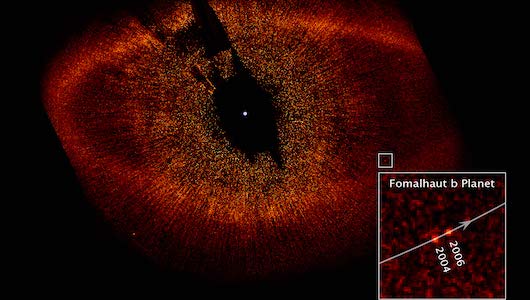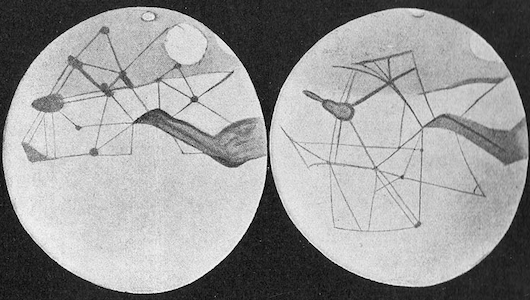 2020
2020
Hubble Space Telescope image of the Formalhaut system, 2004 and 2006. Courtesy of NASA, ESA, and P. Kalas (University of California, Berkeley).
Scientists announced this week that the large exoplanet they believed to have discovered over ten years ago seems to have disappeared. The original 2004 sighting of the object orbiting the star Fomalhaut, captured by the Hubble Space Telescope, marked the first time astronomers had visually detected a planet beyond our solar system. But scientists now know that the Jupiter-sized planet, dubbed Fomalhaut b, was never a planet at all. It was instead a giant cloud of dust caused by the collision of two smaller astronomical bodies.
András Gáspár, an assistant astronomer at the University of Arizona’s Steward Observatory, happened to notice the planet was missing from more recent Hubble Telescope images and discovered that it had been fading from view since it was first observed sixteen years ago. Vice reports:
While cataclysmic collisions are common in the universe, especially in young star systems like Fomalhaut, it is extremely rare to capture imagery of them from Earth. “We know of many other directly imaged exoplanets now,” said Gáspár, who led the new study. “We have never seen anything like this before!”
The discovery was “pure luck,” he added, as he did not specifically set out to observe Fomalhaut b. Gáspár is helping to develop instruments for the James Webb Space Telescope (JWST), NASA’s next-generation observatory, which will be about one hundred times more powerful than Hubble. He was scanning archival Hubble data to calibrate JWST’s optical observations when he noticed the exoplanet’s absence.
The aftermath of this enormous collision is a literal dustup. Some kilometer-scale space rocks probably remain in the mix, but the crash also ejected an expansive shell of “smokelike dust” that has cast a surreal shimmer over the entire system, Gáspár said.
 1903
1903
Illustration of Martian canals by Percival Lowell, c. 1914. Wikimedia Commons.
In 1877 the Italian astronomer Giovanni Schiaparelli observed what appeared to be a network of long straight lines on the surface of Mars. He called his findings canali, mistranslated in English sources as canals instead of channels. The American businessman and astronomer Percival Lowell argued in his books Mars (1895), Mars and Its Canals (1906), and Mars as the Abode of Life (1908) that the only possible explanation for these lines was that they were irrigation canals dug by intelligent beings. Lowell later claimed to have discovered similar features on Venus. Some scholars now believe that what Lowell observed on Venus were shadows cast by the blood vessels in his eye. In 1903 Joseph Edward Evans and Edward Maunder conducted a series of experiments on visual perception with a group of young boys and showed that the lines on Mars were an optical illusion—a blurring together of distinct features—not canals. As they concluded in Monthly Notices of the Royal Astronomical Society:
The canals of Mars may in some cases be…the boundaries of tones or shadings, but that in the majority of cases they are simply the integration by the eye of minute details too small to be separately and distinctly defined. It would not therefore be in the least correct to say that the numerous observers who have drawn canals on Mars during the last twenty-five years have drawn what they did not see. On the contrary they have drawn, and drawn truthfully, that which they saw; yet, for all that, the canals which they have drawn have no more objective existence than those which our Greenwich boys imagined they saw on the drawings submitted to them.
It seems a thousand pities that all those magnificent theories of human habitation, canal construction, planetary crystallization, and the like are based upon lines which our experiments compel us to declare nonexistent; but with the planet Mars still left, and the imagination unimpaired, there remains hope that a new theory no less attractive may yet be developed, and on a basis more solid than “mere seeming.”